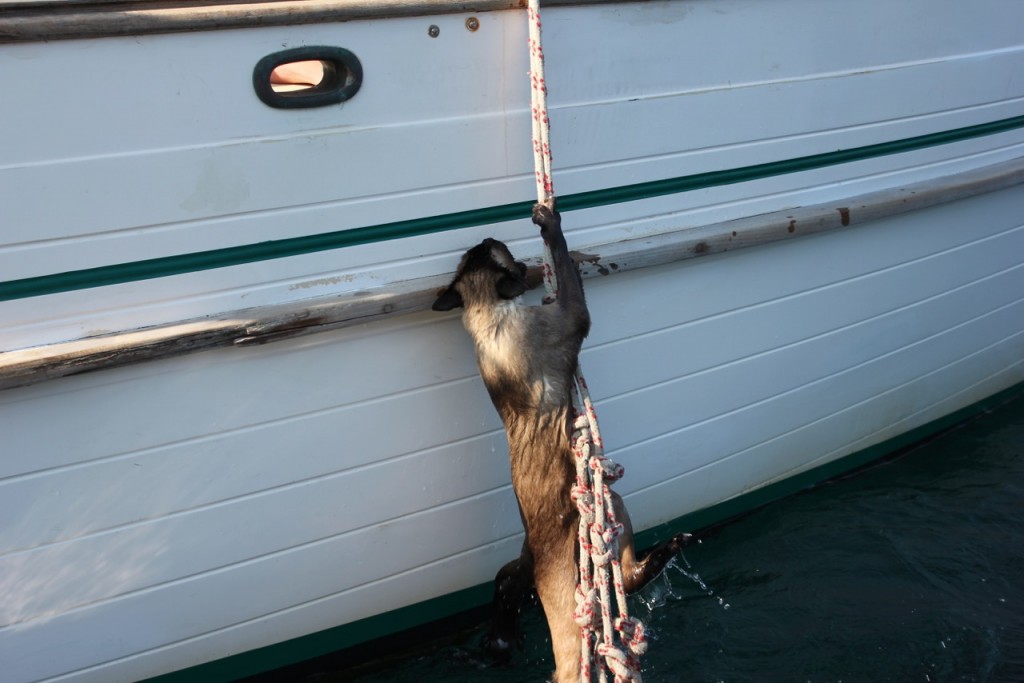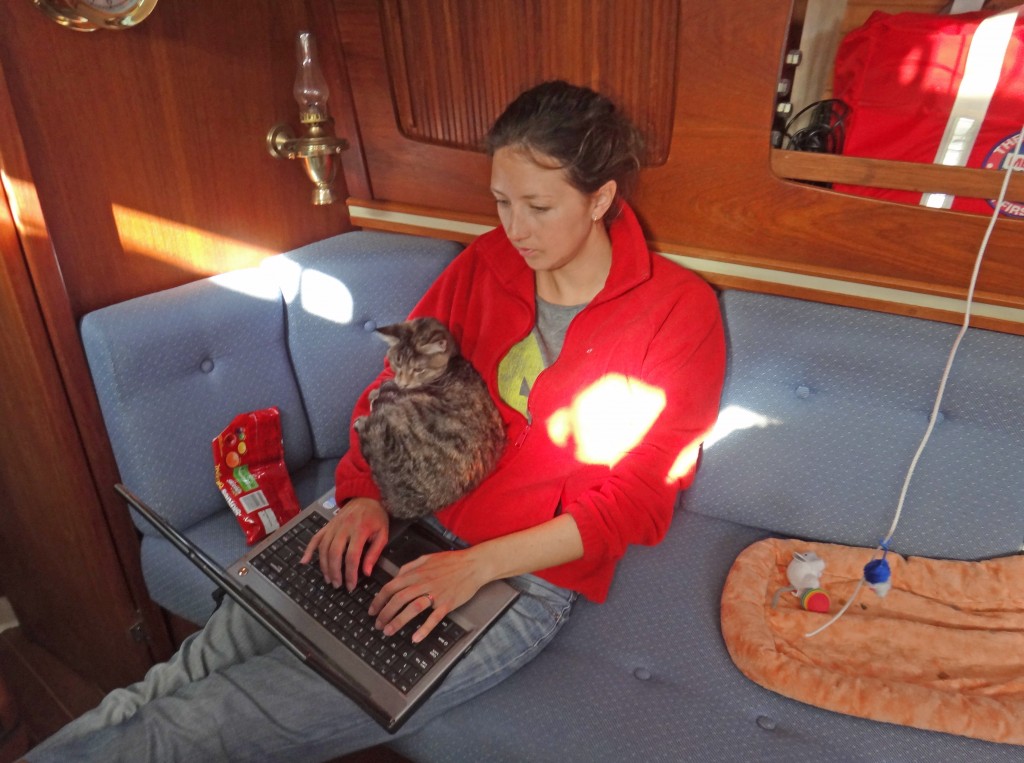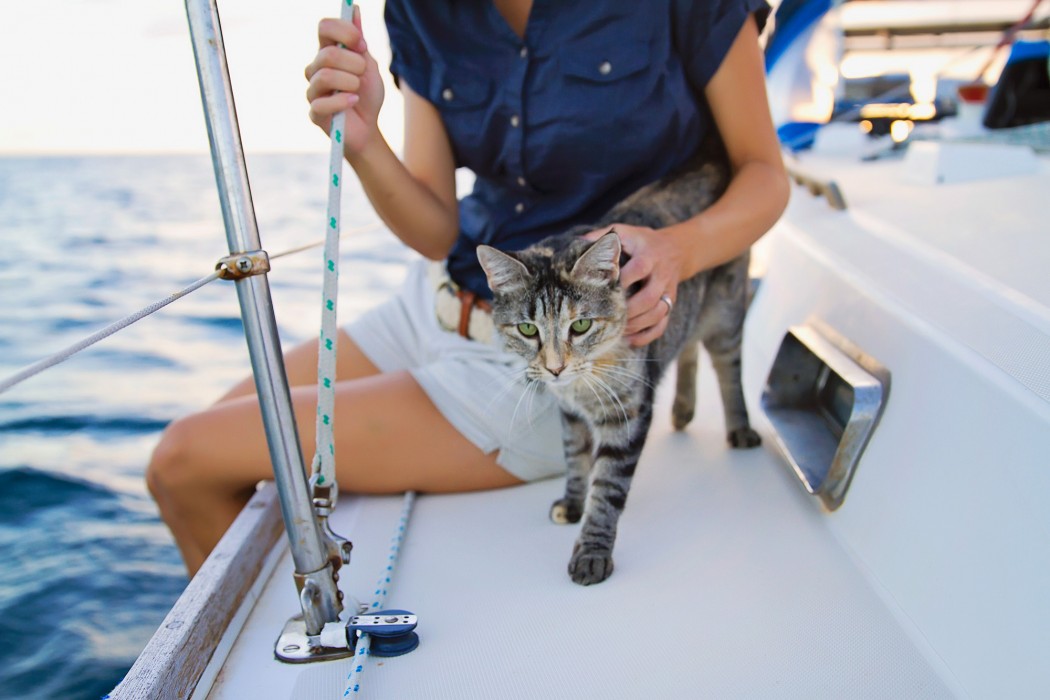Cats have been sailing on boats for centuries. Back in the days of yore, ships’ cats served as handy mousers, and they were also revered as good luck charms. While mousing and good luck are certainly still welcome aboard today’s vessels, modern sailors have also come to enjoy the kitty camaraderie of their cat commodores.
If you’re a captain considering a feline first mate, there are a few things to know and some precautions to observe in order to run a tight ship. As with any adventure on land or sea, safety should always come first.
Here, kitty kitty
It’s a smart idea to train your cat to come when called in case of emergency. We have helpful guides that explain how you can teach your cat the basics of both clicker training and responding to the sound of your voice. These are good practice in general because if your cat gets loose anywhere, proper training can make all the difference.
Invest in a life vest
Just as it is important to utilize a good harness when taking your cat outside, a snug-fitting PFD is key to cat water safety. Most captains find that small dog life jackets work well on their cat companions. Brick-and-mortar stores like West Marine and REI sell jackets that you can see in person. Otherwise, various online retailers have options if you know your cat’s measurements.
When purchasing a PFD for your cat, ensure it’s a proper fit that will stay on should your kitty go overboard, but also doesn’t restrict movement. The flotation device should also have a handle on the back between your pet’s shoulder blades, so that you can lift your cat out of the water by hand or with a hook.

Kuli the surfing cat goes for a swim in Hawaii. (Photo: Alex Gomez and Krista Littleton)
Test the waters
Slowly acclimating your cat to your boat is advisable. Future sailing cats should be introduced to your craft while it’s safely docked for the cat’s entire first visit. Observe how your kitty reacts to the change of scenery both above and below decks. (Make sure your cat is leashed above deck!) Show your cat around and encourage him to explore the nooks and crannies of the cabin. There are lots of cozy places for a snoozing salty kitty to get some zzzs. If your cat takes kindly to your vessel, then perhaps he’s ready to hoist the sails.
If your cat shows signs of fear or is otherwise uncomfortable, slow the process, take a step backward or determine that your feline is more of a landlubber suited for adventures on terra firma. Yo ho, yo ho! The pirate’s life is…not for everyone.
Put your cat to the swim test
In case your cat goes overboard by accident, or if he happens to be the kind of critter who loves going for a dip, it’s important to know your kitty-paddler’s level of ability. Introduce your cat to the water in a situation where you are close by in case of an emergency. Also, your cat will need to learn to swim comfortably while wearing his PFD; this might take some getting used to. Also, swimming requires a lot of energy, so make sure your cat doesn’t overexert himself.
Cutes and ladders
If your cat turns out to be a furry little Michael Phelps, then having a ladder on your boat is an easy way for him to get in and out safely. Accomplished mariner Bailey Boat Cat is a natural with the ladder, for example.

Bailey’s owners trained him to climb up a rope ladder in case he should ever need it. (Photo: Louise Kennedy)
There are a few kinds of ladders to choose from. Some cats can scale steel ladders, but others prefer rope ladders. It will be up to you to determine the best fit for your four-legged pal.
Fishing for cats
Having a long-handled large net on board is a good idea in case your cat accidentally goes overboard. Because cats can’t catch life rings, a net is a smart thing to have — even though hopefully you’ll never have to use it.
Hitting the head
You’ll need to have a litter box secured on your boat so your kitty can relieve himself safely. Most sailors recommend an enclosed box to prevent cat poo from flying around when underway. Boats jostle quite a bit, and a closed box is better for both cat and human alike.
Seasickness: It happens
We’ve all been there, and your kitty co-captain might get there, too. An occasional bout of the mal del mar (or meowl del mar) is nothing to worry about, but if your cat gets sick regularly, then he might be better off staying on land. You can also discuss anti-motion-sickness medications with your veterinarian.
Pro tip: Sailors know that the motion of the ocean is felt more intensely below decks. So if your cat gets seasick while in the cabin, fresh air might provide some relief. Bailey Boat Cat’s human, Louise Kennedy, explains how she handles Bailey’s occasional nausea: “We comfort him and encourage him to get some fresh air in the cockpit which, like humans, helps him feel better.”
Know where you cat is at all times
Larger boats provide cats with the ability to be safe below deck; however, it’s advisable to secure objects that could bounce around and hurt your cat while underway. If your cat is above deck, some kind of tethering is recommended.

Georgie clearly enjoys the sailing life. (Photo: Jessica and Matt Johnson)
Prepare and pack
Plan appropriately for every excursion. Before packing for your adventure, make a list of your cat’s needs from food and water to a pet passport, if you plan to travel in international waters. Always look up the pet policies for your destination and make sure you have the appropriate documentation.
Sailing with cats provides companionship at sea, bonding opportunities and many chances for photos of glamorous adventure cats enjoying the yacht life, so having a cat on your boat might just put the wind in your sails.




